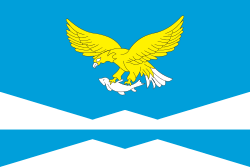Top Qs
Timeline
Chat
Perspective
Flag of Irkutsk Oblast
From Wikipedia, the free encyclopedia
Remove ads
The flag of Irkutsk Oblast depicts three vertical stripes in the ratio 1:2:1: blue on the hoist and fly and white in the middle. Within the white strip, a stylized black tiger-beaver hybrid (the same depicted on the oblast's coat of arms, known as a heraldic babr) is seen holding a red sable in its mouth. These two are surrounded by branches of cedar. The blue represents the waters of Lake Baikal, while white represents purity, goodness, and honesty. The green of the cedar branches represents hope, joy, and abundance.[1][2]
You can help expand this article with text translated from the corresponding article in Russian. (July 2023) Click [show] for important translation instructions.
|
Remove ads
Origin of the babr
Initially, in Siberia, the word babr (бабр, derived from the Siberian Turkic borrowing of the word in Persian) signified a Siberian tiger, as opposed to the tigr (Russian: тигр) used in western Russia. It first appeared in the coat of arms of Yakutsk under the former, correct interpretation in 1642, later becoming the heraldic symbol of Irkutsk in 1690 after the transfer of the headquarters of the governors of Siberia.[3] However, officials in St. Petersburg were unaware of the word's meaning when modifying the coat of arms of Irkutsk in the late 1870s, and someone assumed it to be a misspelling of the Russian word bobr (бобр), meaning beaver. This then had to be reconciled with pre-existing heraldry depicting a tiger, resulting in a hybrid with the body and face of a tiger but the legs, feet, and tail of a beaver.[4] The error went unnoticed until 1997 when the coat of arms came up for review again, although due to its longstanding use under the erroneous definition, the current babr still more resembles it than the initial correct definition.
Remove ads
Other flags
Remove ads
References
Wikiwand - on
Seamless Wikipedia browsing. On steroids.
Remove ads











































